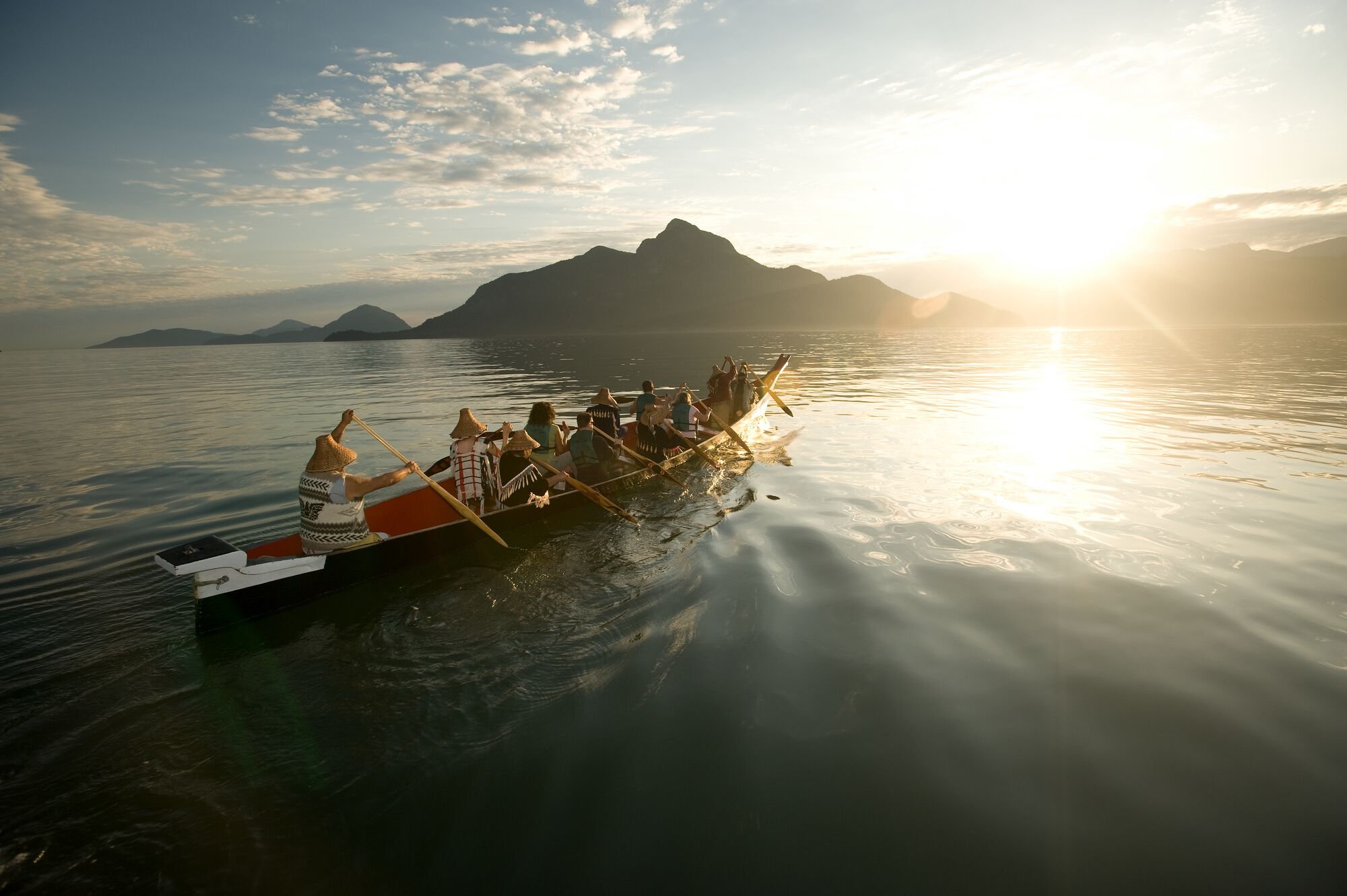
Indigenous Relations & Reconciliation.
We believe that sustainable trail-building work, outdoor recreation projects, and collaboration with Indigenous communities must go hand in hand. Doing so will ensure the long-term sustainability of the trails and activities we love. We call this Working in a Good Way.
Destination BC | Patrice Halley photo
Stories on Reconciliation & the Outdoor Sector
“Together, Canadians must do more than just talk about reconciliation; we must learn how to practice reconciliation in our every day lives - within ourselves and our families, and in our communities, governments…. To do so constructively, Canadians must remain committed to the ongoing work of establishing and maintaining respectful relationships.
— National Center for Reconciliation
The following stories show how people and organizations work towards better representation and relationship building in BC’s outdoor recreation sector.
Featured Blog Stories
More Stories
SORCA and Squamish Nation Memorandum of Understanding
The Squamish Off-Road Cycling Association (SORCA) and the Squamish Nation signed a Memorandum of Understanding (MOU) that affirms a partnership between the two, sharing stewardship responsibilities on trails and recreational areas in the Xay Temíxw (Scared Land) of the Squamish territory. Read more here.
Shuswap Trail Alliance and Secwépemc Create Understanding through Trails
The Shuswap Trail Alliance is a leader throughout the Shuswap watershed in Indigenous relationship Building. They made a significant effort to engage the Secwepemc peoples in developing their trail strategy and are working on the Secwépemc Landmarks Project to create awareness of Secwépemc traditional territory.
The Lower Fraser Collaborative Table Work to Prevent Further Decline of Fish Stocks in the Fraser River
The collaborative table includes twenty-three First Nations, commercial and recreational fishers that are promoting collaboration and civil dialogue. Read more about it here.
The Lower Fraser Fisheries Alliance is a voice of the First Nations of the Lower Fraser River. You can read more about it here.
The Indigenous Youth Mountain Bike Program Reconnects Youth with the Land
Indigenous Youth Mountain Bike Program assists First Nations with trail development, enables youth to reconnect with the land, and promotes the assertion of Indigenous rights and title by encouraging First Nations youth to participate in mountain biking.
Simpcw First Nation – Trails and Indigenous Rights & Title
The Simpcw First Nation, a Secwepemc Nation, are a trails and mountain bike Nation. They worked with the Western Canada Mountain Bike Tourism Association to develop trails and recreation plans that support their role as caretakers and stewards. The Nation has a trail building company which supports trails and recreation throughout the region. Read more about it here and here.
Indigenous Women Create Space to Connect with the Land and Each Other
Indigenous Women Outdoors is an organization that eliminates barriers to getting into nature for women (including gender expansive community members such as cis women, trans women, non-binary, gender non-conforming, gender queer community members, and any women-identified community members) living on unceded Sḵwx̱ú7mesh, Líl̓wat, səlil̓ilw̓ətaʔɬ and xʷməθkʷəy̓əm territories.

Resources
Knowledge and understanding are key to building better relationships with Indigenous Peoples. We have put together a few resources that can help you get started.
Please remember that building relationships can take time, and it will not look the same for everyone. If you need more help getting started, please reach out to us as we may be able to point you in the right direction.
I want to learn about
-
Read “Working in a Good Way,” for information and tips on trail and outdoor recreation projects. “Working in a Good Way” is a guide authored by Patrick Lucas, co-founder of Indigenous Youth Mountain Bike Project, and published by ORCBC.
Watch “Decolonizing Outdoor Spaces,” a webinar co-hosted by ORCBC and the Wilderness Committee - May 2021.
For Section 57 Authorization applications, reference Phase 3 of the “ORCBC Guidelines for Applications to Construct of Maintain a Trail or Recreation Facility.”
Read the stories on this page for examples of what others have done.
-
Explore Indigenous Corporate Training Inc.’s website which includes training, blog posts, newsletters, books and more. This is an incredible resource for anybody that is looking to work with Indigenous Peoples.
Explore the Province of BC’s resources on consulting with First Nations - which include procedure, legal obligations, and recommendations.
-
View Native Land’s Guide to Territory Acknowledgements.
-
First, Identify your local Indigenous communities. We recommended looking at the following maps.
For an interactive map including territories, languages, art, and culture in BC visit the First Peoples’ Cultural Council website.
For a world map visit Native Land’s website. This interactive map has information on territories, languages, and treaties.
For an interactive map showing the location of First Nations communities in BC, visit the British Columbia Assembly of First Nations’ website.
Second. After identifying your local Indigenous communities, visit their website for more information. Most First Nations have their own website that contains key information.
-
Explore the Indigenous Foundations website for information on key topics regarding histories, culture, and politics of the Indigenous Peoples of Canada.
-
Learn more about UNDRIP.
-
British Columbia
Read about The Declaration on the Rights of Indigenous Peoples Act in British Columbia - which was created as a result of the Truth and Reconciliation Commission’s calls to action. It establishes the United Nations Declaration on the Rights of Indigenous Peoples (UNDRIP) as the Province’s framework for reconciliation.
Read about the Province’s 5 Year Action Plan to implementing the Declaration on the Rights of Indigenous Peoples Act.
Read about Indigenous Initiatives in the BC Public Sector.
Canada
Read about the Truth and Reconciliation Commission of Canada - which was created as a result of the Indian Residential Schools Settlement Agreement to facilitate reconciliation among former students, their families, their communities and all Canadians.
-
Indigenous Protected and Conserved Areas (IPCAs) are lands and waters where Indigenous governments have the primary role in protecting and conserving ecosystems through Indigenous laws, governance and knowledge systems. Examples include Tribal Parks, Indigenous Cultural Landscapes, Indigenous Protected Areas, and Indigenous conserved areas.
In 2017, an Indigenous Circle of Experts convened to discuss Indigenous-led conservation IPCAs. Here’s their report: We Rise Together: Achieving Pathway to Canada Target 1 Through the Creation of Indigenous Protected and Conserved Areas in the Spirit and Practice of Reconciliation.
Our Efforts
The Outdoor Recreation Council of BC recognizes the need to focus on building relationships with Indigenous Peoples in the outdoor recreation sector. We strive to provide guidance and resources to the outdoor recreation sector on working cooperatively with Indigenous governments and communities on outdoor recreation projects.
The list below shows some of the steps we have taken. We look forward to continuing to build on our efforts and support the outdoor recreation sector.
Established Indigenous Reconciliation as a Guiding Organizational Value
A guiding value of the ORCBC is Indigenous Reconciliation. We acknowledge Indigenous rights and title and support increasing the capacity of Indigenous peoples in BC to steward their lands and waters as key to the future of healthy ecosystems, communities and respectful recreation.
Prioritized Indigenous Reconciliation as a Goal in our Strategic Plan
A major goal for the ORCBC is to “Pursue Indigenous reconciliation and relate the process to the outdoor recreation sector within the context of BC’s legislation to implement the United Nations Declaration on the Rights of Indigenous Peoples.” - Strategic Plan 2021-2025
Published a Best Practices Guide - “Working in a Good Way”
Authored by Patrick Lucas, co-founder of Indigenous Youth Mountain Bike Project and published by ORCBC, “Working in a Good Way” is a best practices guide for engaging and working with Indigenous Peoples on trails and outdoor recreation projects in British Columbia. We encourage other organizations and our members to review this guide.
Hosted Educational Webinars
In May 2021, we co-hosted “Decolonizing Outdoor Spaces” with the Wilderness Committee. You can watch the recording here.
In January 2021, we hosted “Working in a Good Way: Best practices and lessons learned for settlers and Indigenous peoples collaborating as allies and accomplices in recreation and reconciliation” with Patrick Lucas and Tom Eustache
Produced the “Working in a Good Way” Series of Blog Stories
In 2022, we are featuring a series of stories about reconciliation in the province. You can find them on our blog.
Established a Reconciliation Committee
At the end of 2021, the ORCBC’s Board of Directors established a Reconciliation Committee. The Reconciliation Committee is comprised of representatives from various ORCBC member organizations who are building the path to defining what reconciliation may look like for us and the outdoor recreation sector.
Members are:
Rod Clapton, Reconciliation Committee Chair and ORCBC director (BC Federation of Drift Fishers)
Peter Sprague (BC Off-Road Motorcycle Association)
Norman Marcy (BC Marine Trails)
Wayne Mercer, ORCBC Chair (Quadriders ATV Association of BC)
Eric Vanderkruk, ORCBC Vice-Chair (IMBA Canada)
David Oliver, ORCBC director (BC Wildlife Federation)
Ciel Sander, ORCBC past Chair (Trails BC)
Kim Reeves, ORCBC director (4 Wheel Drive Association of BC)
Dave Wharton, ORCBC director (Federation of Mountain Clubs of BC)
Louise Pedersen, ORCBC staff
Created a Reconciliation Statement
In October 2022, we finalized a statement on how the Reconciliation Committee and the ORCBC Board of Directors view our role in pursuing reconciliation with Indigenous Peoples and relating the process to the outdoor recreation sector. We see this statement as a living document that will change as we do some more “walking around” (MBWA). We recognize this is just the beginning of a long process, and we look forward to continuing this journey with our members.







